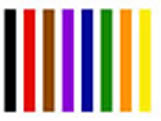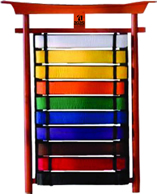|
Jiu Jitsu Belt |
   |
| Belts (basic & rank series) |
| Model No. |
Detail |
Size |
| Basic Series |
Traditional Belts, Fasten Colour, 8 row of stitches, 40+ mm wide. |
140 to 200 cm |
| Rank Series |
Traditional Belts, Fasten Colour, 9 row of stitches, 45+ mm wide. |
| |
All Colour available: White, Yellow, Orange, Green, Blue, Purple, |
| |
Brown, Red, Black |
|
| Belts (master & grand master series) |
| Model No. |
Detail |
Size |
| Master Series |
Silky Traditional Belts, Fasten Colour, 10 row of stitches, 50+ mm wide, only Black Belt, for Embroidery additional charges. |
140 to 200 cm |
| G. Master Series |
Silky Traditional Belts, Fasten Colour, 12 row of stitches, 60+ mm wide, only Black Belt, for Embroidery additional charges. |
|
|
Jius Jitsu Belt Ranking System |
 |
Brazilian Jiu-Jitsu Ranking System |
The Brazilian jiu-jitsu ranking system is a means of signifying a practitioner’s increasing levels of technical knowledge and practical skill within the art of Brazilian jiu-jitsu. Colored belts that are worn as part of the uniform are awarded to the practitioner. While the ranking system's structure shares its origins with the Judo ranking system and that of all colored martial arts belts, the Brazilian jiu-jitsu ranking system grew to incorporate unique aspects and themes. The system has minor differences from Judo in areas such as a division between youths and adults and the issuance of stripes and degrees. Some distinct differences have become synonymous with the art, such as a marked informality in promotional criteria, a focus on a competitive demonstration of skill, and a conservative approach to promotion.
History
In 1907, Kanō Jigorō, the founder of Judo, introduced the use of belts (obi) and gi (judogi) in the martial arts, replacing the practice of training in formal kimonos. In 1914, Kanō's pupil Mitsuyo Maeda arrived in Brazil, a journey which led to the development of Brazilian jiu-jitsu. At the time Kanō used only white and black belts, with white representing the beginner, as a color of purity and simplicity, and black being the opposite, representing one who is filled with knowledge.
Some believe that Mikonosuke Kawaishi was the first to introduce additional colors in 1935 when he began teaching Judo in Paris, 10 years after Carlos Gracie opened his academy in Brazil. Kawaishi thought that a more structured system of colored belts would provide the western student with visible rewards to show progress, increasing motivation and retention. Since then, Brazilian jiu-jitsu, Judo and many other martial arts have adopted the use of colored belts to denote students' progression in the arts. |
| Go Back To Jiu Jitsu Products |
|
|
|